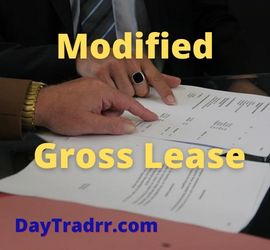What Is a Modified Gross Lease?
 A modified gross lease is a rental agreement where the landlord and tenant share the responsibility of paying a property’s operating expenses. In general, the tenant pays base rent but also bears a proportional amount of the property’s other expenditures. For example, property taxes, utilities, insurance, and maintenance. A modified gross lease is commonly utilized in commercial premises with several tenants, such as office buildings.
A modified gross lease is a rental agreement where the landlord and tenant share the responsibility of paying a property’s operating expenses. In general, the tenant pays base rent but also bears a proportional amount of the property’s other expenditures. For example, property taxes, utilities, insurance, and maintenance. A modified gross lease is commonly utilized in commercial premises with several tenants, such as office buildings.
Commercial real estate leases are usually classified into two types based on rent calculation methods: gross and net. A modified gross lease is a hybrid between a gross lease and a net lease. A gross lease is structured such that the landlord pays for operational expenditures. With a net lease, the property expenses are passed on to the tenant. Both parties should thoroughly analyze all aspects of the agreement. Leases generally include standard terms. However, a modified gross lease should be interpreted as a one-of-a-kind contract for a specific scenario.
How a Modified Gross Lease Works
A modified gross lease is sometimes also known as a modified net lease. Either term is accurate as it is a hybrid of a gross lease and a net lease. The modified gross lease is a cross between these two types of leases. In practice, the operational expenditures are shared by both the landlord and the tenant. With a modified gross lease, the tenant assumes responsibility for expenses directly connected to his or her unit. This would include unit maintenance and repairs, utilities, and janitorial charges. However, the owner/landlord continues to bear responsibility for the remaining operational expenses.
The amount to which each party is responsible is discussed in the lease terms. The expenditures for which the tenant is accountable might vary greatly from property to property. Therefore, a potential tenant must confirm that a modified gross lease clearly outlines which expenses are the tenant’s responsibility. For example, the terms may require tenants to pay their proportionate part of the total heating and cooling expenditure.
Gross Lease vs Net Lease vs Triple Net Lease
Gross Lease
The owner or landlord pays all of the property’s running expenditures. This includes real estate taxes, property insurance, structural and exterior maintenance, and repairs. Also, common area maintenance and repairs, unit maintenance and repairs, utilities, and janitorial fees. Gross leases require a rental figure that covers rent as well as extra expenditures such as utilities and maintenance. The amount payable is often presented as a flat charge that the renter pays to the landlord each month. In exchange, the tenant receives exclusive use of the property. This can be advantageous for a renter since it helps them to properly budget for business-related expenses.
Net Lease
A net lease is more frequent in single-tenant buildings. This agreement transfers property expenditure obligations to the tenant. In most cases, net leases are utilized in combination with tenants such as big restaurant chains. Many commercial real estate investors who want ownership but don’t want the hassle of upkeep opt for net leases. Landlords can ask a cheaper rent because they pass on the costs of the building to the renter via a net lease. For example, insurance, maintenance, repair, and property taxes.
Triple Net Lease
Triple net leases are often used for larger and more complicated constructions. For example, a strip mall or a chain business like Pizza Hut or Burger King. These leases are quite common with big single-tenant properties like restaurant franchises. This is because they provide a desirable and successful investment for the property owner. Typically, they have more complicated leases because the tenant is responsible for rent as well as all operating costs. For example, real estate taxes, insurance, maintenance, and utilities, depending on the category of building and unit leased. As a result, the tenant pays all running expenditures and property charges as part of their own company expenses.
When to Use a Modified Gross Lease
Modified gross leases are common when multiple tenants occupy an office building. For example, consider an office building with a single electricity meter. In that case, the expense of a $1,000 monthly power would be distributed equally among the occupants. If there are five renters, each pays $200. Alternatively, each tenant may pay a proportionate amount of expenses based on square footage. The energy bill would be divided by the percentage of the total square footage that the tenant’s unit occupies. However, if each unit has its own meter, each tenant pays the exact amount of electricity used. Under a modified gross lease, the landlord typically pays extra building-related expenditures such as taxes and insurance.
Pros and Cons of a Modified Gross Lease
Using a modified gross lease, like any other commercial transaction, includes advantages and disadvantages for both renters and landlords. There are clear benefits and drawbacks to choosing a modified gross lease. It can be a great compromise choosing between the two commercial real estate extremes of gross and net leases. A modified gross lease is often a good choice for both renters and landlords. It allows renters to pay for expenditures over which they have authority. Still, the landlord maintains control over certain duties like common area maintenance charges.
- Tenants – When the landlord bears the costs of upkeep and other related expenses, the renter benefits. The tenant has greater budgetary control on expenditures directly associated with its company. For example, rent, business taxes, salaries, and so on. However, if the landlord is negligent in general upkeep, this may be a problem for tenants. Particularly those who rely on the look of their office or retail space to attract and maintain customers. The tenant will have less control over a number of aspects of the building that may impact their business
- Landlords – Landlords can be certain that their property is being kept to the standard they prefer. Some renters may not be as timely when it comes to completing repairs or upkeep on the external areas. One downside is that the running expenses may be undervalued. The landlord may be charging insufficient rent for a facility that requires a lot of maintenance. A property with a modified gross lease necessitates extra time and resources on the part of the investor to manage. They will also have to take on extra financial risk as a result of unforeseen or unexpected expenditures that arise when the property requires repairs or upkeep.
Example – Standard Form Modified Gross Office Lease
Landlord hereby leases to Tenant, and Tenant hereby leases from Landlord, upon all of the terms, provisions, and conditions contained in this Lease, (i) those certain premises described in the Principal Lease Provisions, below (the “Premises”), consisting of a portion of that certain building described in the Principal Lease Provisions, below (the “Building”), which is, in turn, a part of the Project (as described in the Principal Lease Provisions, below), along with (ii) the non-exclusive right to use, in common with Landlord, Landlord’s invitees and licensees, and the other tenants and users of space within the Project, those portions of the Project intended for use by, or benefiting, tenants of the Project in common including, without limitation:
The landscaped areas, passageways, walkways, hallways, elevators, parking areas, and driveways of the Building and the Project, but excluding all interior areas of the other buildings which may now or in the future be located in the Project other than the Building (collectively, the “Common Areas”). This Lease confers no rights, however, to the roof, exterior walls, or utility raceways of the Building nor rights to any other building in the Project, nor with regard to either the subsurface of the land below the ground level of the Project with regard to the air space above the ceiling of the Premises;
Provided, however, that Tenant shall have the limited right to access systems and equipment exclusively serving the Premises (for which Tenant has maintenance and repair responsibilities pursuant to Paragraph 10.1 below) that may be located on the roof, in exterior or demising walls, in utility raceways, in the airspaces above the ceiling of the Premises, or in any other portion of the Building or the Common Areas for the sole purpose of maintaining, repairing, and replacing such systems and equipment. (Source: sec.gov)
Up Next: What Is Subordinated Debt?
 Subordinated debt is an unsecured obligation that ranks lower in terms of claims on assets or profits than more senior loans or obligations. This type of debt is also known as a subordinated debenture. It is an unsecured loan or bond that ranks lower in terms of claims on assets or profits than other, more senior loans or securities. As a result, subordinated debentures are often referred to as junior securities. In the event of borrower default, subordinated debt creditors will not be reimbursed until senior bondholders have been paid in full.
Subordinated debt is an unsecured obligation that ranks lower in terms of claims on assets or profits than more senior loans or obligations. This type of debt is also known as a subordinated debenture. It is an unsecured loan or bond that ranks lower in terms of claims on assets or profits than other, more senior loans or securities. As a result, subordinated debentures are often referred to as junior securities. In the event of borrower default, subordinated debt creditors will not be reimbursed until senior bondholders have been paid in full.
Even within the category of subordinated debt, however, there are many sorts of loans with varying degrees of priority. High yield bonds, mezzanine with and without warrants, Payment in Kind (PIK) notes, and vendor notes are examples of subordinated debt, with the highest priority coming first. There are different degrees of expected return for different levels of subordination. As a result, investors base their judgments on the risk-reward tradeoff. High-yield bond investors, for example, have the greatest priority to collect debt in the event of financial trouble. As a result, they will get the lowest return of all subordinated debt creditors. Vendor note creditors, on the other hand, have the lowest priority for debt collection but the greatest projected return of any lender.




